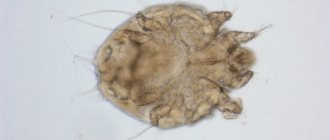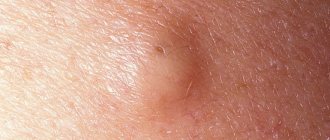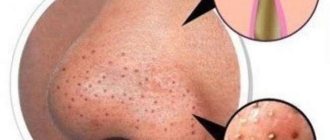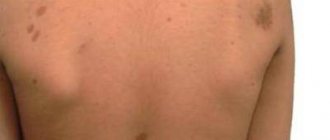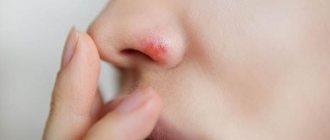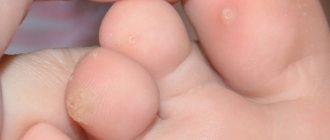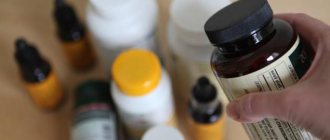Serious complications associated with various diseases of the body, and a violation of the general nutrition of tissues, accompanying external compression of areas of the body, lead to the development of bedsores.
In medicine, the concept of “ulcer” is often encountered. Often, bedsores in bedridden patients occur due to the inability to lead a normal lifestyle. External compression, especially in places where bones protrude, leads to the formation of skin disorders. Patients undergoing tissue innervation have various types of pathologies or suffer from spinal cord injuries. Places that receive greater pressure from weight become prime areas for pressure sores to appear (heels, buttocks). Thus, it is simply necessary to take preventive measures and treat bedsores in a timely manner.
What is a bedsore?
Bedsores (decubitus) are necrosis (death) of soft tissue, followed by ulcers in places where the skin and/or underlying tissue is damaged.
They occur as a result of lying or sitting in one position for a long time, due to pressure on an area of the body. It especially occurs in sick people who need care and are bedridden. It can only be prevented by treatment and prevention.
On average, a person unconsciously changes his position several times during sleep, so bedsores do not occur even during prolonged bed rest. However, people who are bedridden cannot move or turn around on their own. Without proper care, they are at risk of bedsores.
Which parts of the body are especially at risk?
Erosions (i.e., superficial defects of the epithelium) can occur in all areas of the body where the skin passes only over the bone.
These areas are not protected by muscle or fat tissue. These include:
- elbow;
- forehead, cheekbones;
- sacrum bone (coccyx);
- bulges at the top of the femur;
- heel, ankle.
In the supine , wounds most often occur in the sacrum, heels and elbows. In the lateral position, ulcers appear on the hills of the thighs and ankles.
If the patient lies on his stomach, tissue necrosis forms on the forehead and cheekbones. Also, the areas of skin between the fingers and toes are at risk.
Diaper rash and bedsores: how to treat at different stages
Diaper rash and bedsores: what's the difference?
In seriously ill people, especially bedridden people, the condition of the skin changes over time, the level of collagen and fat production decreases, which leads to increased sensitivity, thinning and dryness. At the same time, the skin is easily injured and takes a long time to heal, and the lack of proper care and air baths provokes irritation and infections. Most often, under these conditions, the patient develops diaper rash and bedsores. Good patient care reduces the likelihood of developing skin complications by 70%.
Diaper rash differs from bedsores in the main symptoms of manifestations, mechanism of development and preferential localization:
- bedsores: discoloration of the skin with clear boundaries, swelling, weeping wounds with rapid damage to the underlying tissues (in the absence of timely care and treatment measures); are formed as a result of constant compression of soft tissues and are most often localized on the heels, knees, elbows, tailbone, buttocks, etc. (localization depends on the predominant position of the patient);
- diaper rash: itchy irritation, burning, pain, discoloration of the skin with blurred boundaries, unpleasant odor; most often form in places of constant friction of the skin, high humidity and lack of air exchange: on the neck, in the armpits, under the breasts (in women), in the folds of the abdomen, in the groin folds, between the fingers.
How to recognize the stage of skin damage
Diaper rash is an inflammatory process that occurs as a result of constant contact of the skin with sebaceous secretions, lack of hygiene, high humidity and friction of the skin. If infected and left untreated, diaper rash becomes a chronic disease.
Diaper rash in the buttock area. Photo: CPP
Diaper rash in the armpit. Photo: CPP
There are 3 degrees of development of diaper rash :
1st degree - initial: redness and itching without visible damage to the skin.
2nd degree - moderate damage: the skin is damaged (ulcers), which is accompanied by itching and burning.
3rd degree - severe lesions : deep non-healing cracks, unpleasant odor and an increase in the affected area combined with burning and pain.
Pressure ulcers are areas of tissue ischemia and necrosis resulting from compression, shearing, or displacement between the human skeleton and the surface of the bed.
There are 4 stages of development of bedsores :
Stage 1 - fading redness : a pale area of skin or persistent hyperemia that does not go away after the pressure stops; the skin is not damaged; finger pressure in the center of the redness zone causes the skin to turn pale - this phenomenon proves that microcirculation is not impaired.
Stage 1 bedsore on the back. Photo: CPP
Stage 1 bedsore. Photo: ECDO Center
Stage 2 - non-fading redness : skin color - bluish-red, with clear edges; superficial violation of the integrity of the skin (abrasions, blisters or flat crater) extending to the subcutaneous tissue; usually accompanied by pain.
Stage 2 bedsore. Photo: CPP
Stage 2 bedsore. Photo: CPP
Stage 3 - damage to the skin to the muscle layer or with penetration into the muscles : the edges of the wound are well demarcated, surrounded by swelling and redness; the bottom of the wound may be filled with yellow necrosis or red granulation; There may be liquid discharge and pain.
Stage 2 bedsore. Photo: CPP
Stage 3 bedsore. Photo: CPP
Stage 4 - damage to all soft tissues, tendons and bones are visible : many holes are formed that can connect; the bottom of the wound is often filled with black necrosis and black-brown masses of disintegrating tissue.
Stage 4 bedsore. Photo: CPP
Last stage bedsore, tissue necrosis. Photo: ECDO Center
Reasons for appearance
Diaper rash and bedsores are the first sign that you need to monitor the patient more closely and that his care is insufficient.
The main causes of diaper rash:
- excess body weight;
- increased sweating, urinary incontinence;
- circulatory disorders;
- allergic reactions;
- changes in blood sugar levels, disruption of metabolic processes in the body.
Among the main causes and risk factors for the development of pressure ulcers there are both reversible (conditions and conditions that can be corrected) and irreversible.
- Internal: wasting/obesity, limited mobility, anemia, dehydration, heart failure, hypotension, urinary and fecal incontinence, pain.
- External: poor care, incorrectly selected means and methods of care, violation of the rules for positioning the patient in a bed or on a chair, non-compliance with moving techniques, lack of protein and ascorbic acid in the diet (decreased or lack of appetite), taking medications (cytostatics, NSAIDs, hormones) , changes in the microclimate of the skin (overheating, hypothermia, excessive moisture, dryness).
- Internal: old age, terminal condition, neurological disorders (sensory, motor), changes in consciousness (confusion or loss of consciousness).
- External: previous extensive surgery lasting more than 2 hours, trauma.
What does a bedsore look like in a person (symptoms)?
The first signs of a developing pressure ulcer: redness , which persists even in the absence of pressure. At the initial stage, patients often do not notice erosion.
Without proper treatment, the bedsore continues to spread. Subsequent stages of superficial skin damage occur with deep bleeding wounds with inflammation of muscle and bone tissue.
Other possible symptoms, e.g.
- itching;
- strong pain;
- and burning in the affected area.
However, people suffering from nerve damage due to other diseases may experience few or no symptoms even in advanced stages.
In addition, if pathogenic microorganisms (viruses, bacteria, etc.) enter the ulcer, an unpleasant odor occurs.
Diaper rash or bedsores - what's the difference?
Diaper rash is an inflammatory process that occurs as a result of lack of hygiene, high humidity and constant friction of the skin. In case of infection and lack of quality care, diaper rash becomes a chronic disease. Treatment of such inflammations can last several years.
Doctors distinguish 3 stages of development of diaper rash:
- Initial stage. Redness, itching. There are no visible damage to the skin.
- Average degree of damage. Formation of ulcers.
- Severe degree. The appearance of deep non-healing cracks, an unpleasant odor and an increase in the affected area.
Bedsores are damage to the skin on protruding parts of the body. Pressure wounds are formed as a result of constant compression of soft tissues (on the heels, knees, elbows, buttocks, tailbone, etc.). In bedridden patients, bedsores form due to prolonged stay in one position on unevenly straightened bed linen or on an uncomfortable anti-bedsore mattress. There are 4 stages of development of pressure wounds: initial, transitional, severe, extremely severe.
To determine what exactly has formed in a bedridden patient, bedsores or diaper rash, you need to know how they differ and the main symptoms of manifestation:
| Name | Symptoms |
| Bedsores | Change in skin color, swelling, the appearance of weeping wounds, tissue damage. |
| Diaper rash | Itchy irritation, burning, pain, change in skin color, unpleasant odor. |
Classification of bedsores
Doctors divide bedsores into grades I-IV:
- Degree I: hyperemia (redness), swelling of damaged skin areas. If you remove pressure from the affected area, the irritation does not go away. The skin area may be warmer than usual.
- Grade II: Formation of a painful, moist ulcer. Detachment of the upper layers of skin begins, and blisters form.
- Grade III: deep wound. There is abundant fluid discharge from the injury and necrosis.
- Grade IV: The final stage of a pressure ulcer is a deep tissue injury where muscles, bones and tendons are visible (see photo above). As a result, deep erosions (ulcers) form in the bones.
Treatment with herbal remedies
Traditional recipes help further cleanse the wound surface, prevent complications, and gently stimulate the formation of new tissue. When choosing a specific folk remedy, you need to know that it can cause allergies.
[wpmfc_short code=”Down_Up”]
To avoid negative consequences, you need to try a new product on a small area of healthy skin, and only after that treat the wound surfaces. A preliminary consultation with your doctor will not hurt.
Important! All folk remedies can only be used as additional treatment. They cannot eliminate the need for constant use of medications prescribed by a doctor!
To cure deep bedsores on the tailbone, buttocks and other areas, and to prevent complications, it is unacceptable to use products with pronounced tanning properties.
Among the safe means indicated for the treatment of large and deep bedsores, the following should be listed:
- the juice of their fresh lungwort leaves, which need to treat areas of inflammation daily;
- Kolanchoe leaves divided in half are applied cut side to the bedsore, gently fixed with a bandage and left overnight;
- elderberry leaves, pre-treated with boiling milk;
- mix Vaseline with crushed calendula flowers, apply the resulting composition to the wound surface in a thin layer twice a day;
- treatment of complex bedsores can be supplemented with lotions made from freshly grated potatoes with the addition of honey - the same remedy helps prevent the occurrence of such a problem;
- Treating deep bedsores with tea tree oil also helps (sea buckthorn can also be used);
- compress of fish oil (pre-boiled and cooled);
- a mixture of celandine and aloe juice with honey - proportions 2: 2: 1.
If the area of the bedsore is significant and the surface is very wet, you can try starch powder. During treatment with herbal remedies, it is necessary to constantly monitor the person’s reaction, and if local negative effects appear on the remedy, its use should be stopped immediately.
Causes and risk factors
Bedsores occur as a result of prolonged mechanical impact and impaired blood microcirculation, especially after prolonged lying or sitting. Over time, small blood vessels become damaged:
- constant pressure on the skin compresses small blood vessels;
- as a result, the corresponding area is less well supplied with oxygen;
- eventually, the tissue dies, the skin thins and an open wound (ulcer) forms.
In addition to pressure, friction also contributes to bedsores; layers of tissue can rub against the surface, causing damage to small blood vessels.
Risk factors
Various factors contribute to the development of pressure ulcers. These include:
- decreased sensitivity to pain: in some diseases, the patient does not even notice that a part of the body is under pressure. May occur as a result of paralysis, diabetes mellitus, circulatory disorders, due to atherosclerosis, anemia, Parkinson's and Alzheimer's disease, stroke;
- diseases , skin irritations;
- Wetness: For people who spend hours in diapers, wet skin softens over time. This makes them more prone to damage. Not only feces and urine, but also heavy sweating irritate the skin;
- poor nutrition: in cases of malnutrition, the skin is often very thin and has a poor blood supply;
- Obesity: In people who are overweight, damage occurs more quickly because the bone and skin are subjected to greater pressure in bed. In addition, overweight people often sweat excessively, which also contributes to the development of bedsores;
- older people: Older people are more likely to get sick than younger people because they are at greater risk of poor circulation, decreased cardiac output and nervous system disorders. In addition, with age, the skin loses its resistance and elasticity, which can also contribute to the development of bedsores. Urinary incontinence, which is not uncommon in old age, further contributes to bedsores.
Treatment of diaper rash in bedridden patients at home
Folk remedies are an integral part of the treatment of any disease. They are resorted to in cases where drug treatment has no effect, or the positive effect is weakly expressed. Also, with the help of proven folk remedies, when used correctly, you can avoid the occurrence of complications and re-development of the disease.
Important! The use of folk remedies must be agreed with the attending physician. Before you start using any product, you need to make sure that the patient does not have an allergic reaction.
Let's answer the question - how to treat diaper rash in bedridden patients at home. For preventive treatment and treatment of skin from diaper rash, you can use a popular remedy - a decoction of oak bark.
This product has an antiseptic effect and is good for inflammation of the skin. Chamomile, nettle leaves and string are also widely used in folk medicine. Herbal infusions have good wound healing properties. It is recommended to wipe the affected areas in the morning and evening throughout the entire treatment period.
Olive, sea buckthorn, sunflower oils and calendula extract are widely known in the treatment of diaper rash.
The use of oil in the treatment of diaper rash promotes rapid healing of wounds, restoration of tone and elasticity of the skin. To avoid infection of skin wounds, the oil must be sterilized.
Prevention of bedsores
Of course, bedsores can be treated, but it is better to prevent their occurrence. For necrosis, there is a set of preventive measures that, if carried out correctly and in a timely manner, will help avoid the occurrence of ulcers.
Measures to prevent the formation of necrosis in a seriously ill patient are quite simple. It is necessary to change position every 2-3 hours to redistribute the pressure to different parts of the body. An anti-decubitus mattress can perform the same function. In addition, it is imperative to regularly change underwear and bed linen, and monitor the patient’s hygiene.
An additional means of prevention is the use of anti-bedsore drugs: powders, ointments, gels, solutions, patches, aerosols.
Common means used to prevent bedsores are camphor, ammonia and talc. They dry the skin, protecting against diaper rash, which turns into erosion. Protection against diaper rash is the main thing in preventing bedsores. All these measures are mandatory when caring for a bedridden patient.
Prevention should be carried out from the first day of the disease and when the first signs of soft tissue death appear.
Means for uniform distribution of pressure on the body
If regularly changing the patient's position is not enough to prevent bedsores, additional means can be used to help evenly distribute pressure on the body. However, they do not replace regular changes of position.
Places where diaper rash occurs
Most often, diaper rash in bedridden patients occurs in places where there is constant friction of the skin and there is no air exchange:
- on the neck;
- armpits;
- under the breasts (in women);
- in the folds of the abdomen;
- in the groin (in men);
- on the buttocks and tailbone;
- on the foot between the toes.
Treatment of bedsores
If prevention does not help and the patient still develops bedsores, they must be quickly treated to prevent further spread of the wound.
Particularly important: the affected area of the body should be exposed to as little as possible.
Depending on the severity, the ulcer should be treated with special ointments, followed by applying a bandage to the wound.
Remedies for bedsores: effective ointments and gels
Popular medicinal ointments and gels are the following drugs:
- Algofin is an ointment whose main components are chlorophyll and fatty acids. These are natural substances that have a strong anti-inflammatory effect. The drug triggers accelerated regeneration of skin cells. Price 100 rub.
- Zinc ointment is a preparation consisting of petroleum jelly and zinc oxide. Apply to the skin at least 6 times a day. Creates a thin protective film impenetrable to pathogenic microorganisms. It has an antibacterial effect and dries the wound. 20-40 rub.
- Stellanine is a strong anti-inflammatory drug. It is effective in treating the disease; when used, the damaged area of the skin is regenerated. Apply to the skin 3 times a day.
- Fukortsin is a bright pink solution with bactericidal properties. Destroys pathogenic flora.
- Multiferm - used for the treatment of bedsores of the first and second stages. Price 150-160 rub.
Pharmacy ointments and creams
Medicines differ in principle, mechanism of action, effectiveness and side effects.
The most popular medications for bedsores are:
- Hydrocortisone, ointment, relieves inflammation.
- Algofin, in addition to its antimicrobial effect, is capable of restoring damaged tissues.
- Dexamethasone stops the growth of microbes and has an antiallergic effect.
- Vulnuzan accelerates the healing of bedsores with suppuration.
- Pyricarbate improves blood flow, restores blood circulation in the capillaries.
- Tribenoside reduces congestion in the veins and strengthens the walls of blood vessels.
- Bepanthen accelerates skin healing and normalizes cell metabolism.
- Vinilin, a wound-healing ointment, helps to activate the restoration of the epithelium.
- Curiosin (hyaluronic acid) stimulates the restoration of skin cells.
- Trypsin, Chymotrypsin, break down dead tissue, cleanse the wound of necrotic masses, and liquefy viscous secretions.
- Terrylitin has a positive effect on slow healing of bedsores.
